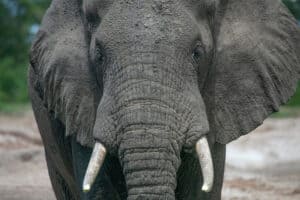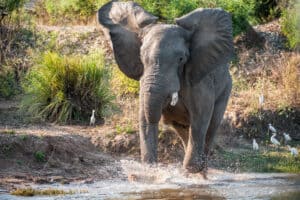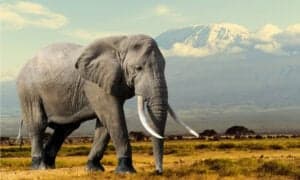Elephants are highly intelligent and social mammals. They are also the largest existing land animals. There are three species that exist today: African bush, African forest, and Asian. Both the African bush and Asian species are endangered, while the African forest species is critically endangered. Of the three living species, African bush elephants are the largest. Males are an average of 10.5 feet tall at shoulder height and weigh an average of 6,000 pounds. The largest African bush elephant ever recorded weighed almost four times this amount! Exactly how big was the largest elephant ever recorded? And how did it grow to be so large? This article explores three key factors that contribute to the impressive size of elephants.

African bush elephants are native to sub-Saharan
Africa
. The species has existed for 7.6 million years.
©Volodymyr Burdiak/Shutterstock.com
How Big Was the Largest Elephant Ever Recorded?
The largest elephant ever recorded was a whopping 24,000 pounds and stood 13 feet tall at the shoulder. To put this weight into perspective, cars generally weigh between 1.5 and 2.5 tons. That means that this elephant weighed as much as between four to seven cars put together! This male African bush elephant was shot in Angola in the 1950s by a Hungarian hunter. The story of this hunting expedition is in a 1956 publication of Sports Illustrated. The body is on display at the Smithsonian National Museum of Natural History in Washington D.C., United States. This incredibly big animal even has a name: Henry.
Henry’s size is far from average. His height is 2.5 feet taller than the average male African bush elephant. The difference in his weight is even more astounding. While the average weight of a male African bush elephant is 6,000 pounds, Henry’s weight is an incredible 24,000 pounds. That’s almost four times heavier than average! Additionally, Henry’s footprint is over 2 feet long. The circumference of his foot is 5 feet and 7.5 inches. From the tip of his trunk to the tip of his tail, he is 27 feet and 6 inches long. At Henry’s widest point, his body has a circumference of 19 feet and 8 inches. This makes Henry the largest animal to ever be shot on land. How did Henry grow to be so large?

3 Reasons Elephants Grow So Large
Elephants are the largest living land animals. While Henry of Angola is the largest one ever recorded, even average-sized elephants are incredibly massive. How do elephants grow so large? Here are three reasons why they are the largest land creatures on Earth.
1. They Eat a Ton of Plants
Elephants are herbivores, meaning they only eat plants. Their diet is mostly grasses and herbs but sometimes includes leaves and tree bark. But they need to eat a ton of plants in order to grow so large. Adults can eat up to 330 pounds of vegetation a day. That’s more than the weight of the average human! Additionally, elephants drink 50–60 gallons of water a day. In captivity, they also enjoy fruits, corn, and sugarcane. How can these animals get so big eating only plants?
It may come as a surprise that the biggest land animals in the world are herbivores. There are a couple of main reasons for this. The first is that plants are an abundant food source. Secondly, herbivores can grow large without the negative consequences a predator would have. A predator needs to be agile in order to hunt. However, this is not a concern for herbivores. This leads us to the next point.
2. They Evolved to Evade Predators
A huge advantage of elephants’ size is their ability to evade predators. They are simply too large for a predator to take down. The main predator elephants have to worry about is lions. However, one lion alone usually cannot kill an elephant. Lions have to hunt in groups to take down the world’s largest land animal. If an elephant does get taken down by a predator, it is typically one that is either small or sick. However, they mostly live in large groups, which helps protect the vulnerable among them.
3. Elephants Share a Common Ancestor with Mammoths

Woolly mammoths lived during an ice age and had thick fur to keep them warm.
©Dotted Yeti/Shutterstock.com
Elephants are so big because they come from a large ancestor. They share a common ancestor with both mammoths and mastodons, two gigantic extinct mammals in the elephant family. Both mammoths and mastodons were similar in size to today’s African bush elephants. However, there are some important differences between elephants and mammoths. First, mammoths had much larger and heavier tusks. Secondly, mammoths and mastodons have been extinct for around 4,000 years.
Thank you for reading! Have some feedback for us? Contact the AZ Animals editorial team.








